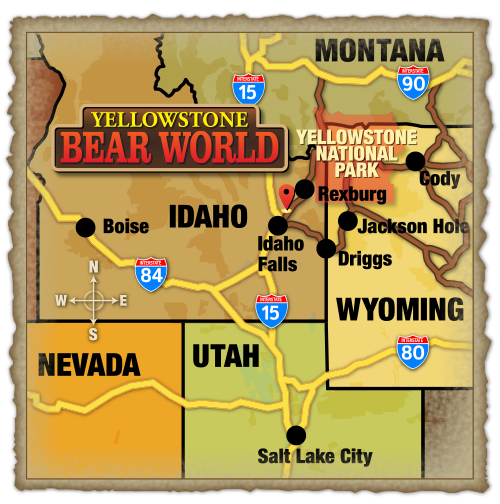Wildlife of Yellowstone Bear World
The animals included in the following list are just a few of the wildlife that visitors will see at YBW. New animals are introduced seasonally. Information: “National Audubon Society: Field Guide to North American Mammals” (1997).
Black Bear
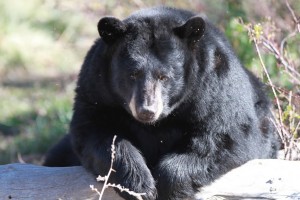
Black Bear
Description:
In the East, nearly black; in the West black to cinnamon, with white blaze on chest. Males (boar), Female (sow), young (cub). HT (3′ – 3’5″), L (4’6″ – 6’2″), WT (203 – 587 lb.). Boars are much larger than sows.
Breeding:
Mates in June – early July. Due to delayed implantation young are born during hibernation in January – early February. Cubs weigh approximately 7 oz. (the size of a “twinkie”). Litter of 1 – 5 (depending on food and fat surplus).
Diet:
Omnivorous- Leaves, twigs, berries, fruit, nuts, insects. Bears will also rips open bee trees to feast on honey, honeycombs, bees, and larvae, and will tear apart rotting logs for grubs, beetles, crickets, and ants.
Range:
Canada, Rocky Mountain States, but very prevalent in the Eastern States MN, MI, WI, NY, PN, NE.
Interesting Facts:
- The black bear’s walk is clumsy, but in its bounding trot it attains surprising speed, with burst up to 30 mph.
- Hibernate in the harshest months of winter.
- Mainly solitary, except briefly during the mating season and when congregating to feed.
Grizzly Bear
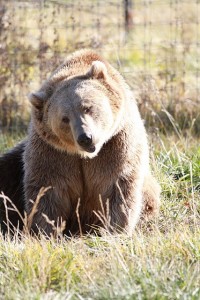
Grizzly Bear
Description:
Yellowish brown to dark brown, often with white-tipped hairs, giving grizzled appearance. Hump above shoulders. HT (approx. 4’3″), L (5’11” – 7′), WT (324 – 1,499 lb.) Not true hibernators, they can be easily awakened.
Breeding:
Mates late June – early July. Litter of 1 – 4 young born in January – March. Newborn weighs 1 lb.
Diet:
Omnivorous, feeds on a wide variety of plant material, including roots, sprouts, leaves, berries, and fungi, as well as fish, insects, large and small mammals, and carrion.
Range:
Alaska, Yukon, and Northwest Territories, south into Nevada.
Interesting Facts:
A Grizzly in captivity has lived 47 years, but the life span in the wild is 15 – 34 years.
Moves with a low, clumsy walk, swinging its head back and forth, but when necessary it can lope as fast as a horse. Normally solitary, they establish dominance through size and threats, spacing themselves out, with the largest, most aggressive individuals taking the choicest stations. Grizzly cubs can climb, though not as nimbly as black bear cubs, but they loose their climbing ability during their first year. In winter, grizzlies put on a layer of fat, as much as 400 pounds.
Rocky Mountain Elk
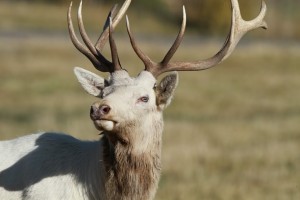
Rocky Mountain Elk
Description:
Brown or tan, underparts darker with a yellowish rump patch. Males have large, many-tined antlers: 6 tines on each side when mature Bull’s drops antlers in winter months and regrow new larger antlers each spring. Male (bull), Female (cow), young (calf) HT (4’6″ – 5′) L (6’8″ – 9’9″) WT (500-1200 lb..)
Breeding:
Mates late August – October. Usually one calf born in late May or June.
Diet:
Grasses in summer, woody plants in the winter months.
Range:
From Eastern British Columbia down the Rocky Mountains to Central New Mexico and Arizona.
Interesting Facts:
This animal marks the areas it frequents by stripping the bark from seedlings, the cow using her lower incisors and the bull the base of his antlers; they then rub the seedlings with the sides of the chin and muzzle. These posts may serve as territorial markers, warning other elk to keep out. The elk vocalizes in several ways. A young elk squeals, and adult snorts and grunts, and a cow neighs to her calves. The alarm call is sharp, barking snort. The “bugle,” or “whistle,” of a bull is a challenge to other bulls and a call of domination to cows; this vocalization begins as a bellow, changes almost immediately to a loud, shrill whistle or scream and ends with a series of grunts. Only the whistle carries over long distances.
Mule Deer
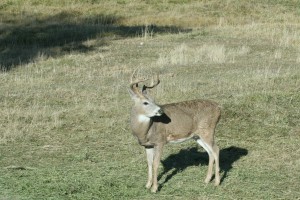
Mule Deer
Description:
Stocky body, with long, slim, sturdy legs. Reddish brown to grayish, white throat and rump patch, with small black tipped tail. Large “mule-like” ears. Buck’s antlers are branched equally, each a separate beam forking into 2 tines. Buck’s drop antlers in winter months and regrow new larger antlers in spring. Males (buck), Female (doe), young (fawn) HT (3′ -3’5″) L (3’10” – 7’6″) WT (100-500)
Breeding:
Mates October – December 1 – 2 young born in June and July. Fawns weigh about 8 lb.. at birth.
Diet:
Grasses, sagebrush, and various other herbaceous plants.
Range:
Southern Yukon and Western Northwest Territories south through Western Texas.
Interesting Facts:
The Mule Deer has glands on the hindlegs above the hooves. A fawn seems able to recognize its mother by the odor from these glands, and when deer are in groups, they frequently sniff these glands
White-tail Deer
Description:
Tan or reddish brown above in summer, grayish brown in winter. Belly, throat, nose band, eye ring, and inside of ears are white. Tail brown, edged with white above. Large white flag-like tail and smaller ears than mule deer. Buck’s antlers have main beam forward, several unbranched tines behind. Buck’s drop antlers in winter months and regrow new larger antlers in spring. Male (buck), Female (doe), young (fawn) HT (27″ – 45″) L (6’2″ – 7′) WT (150 – 350 lb..)
Breeding:
Mates October – December 1 – 2 fawns born June – July
Diet:
Grasses, acorns, nuts and some fruit and shrubs.
Range:
Southern Canada; most of U.S., except far Southwest.
Interesting Facts:
A graceful runner, with top speeds of up to 36 mph, although it flees to nearby cover rather than run great distances. If alarmed, the deer raises, or “flags,” its tail, exhibiting a large, bright flash of white; this communicates danger to other deer and helps a fawn follow its mother in flight. A Whitetails’s age is determined not by the number of tines on its antlers, but by the wear on its teeth.
American Bison
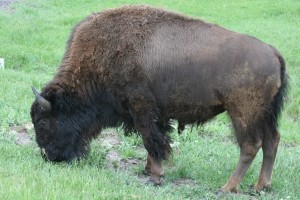
American Bison
Description:
The largest terrestrial animal in North America. Dark brown, with shaggy mane and beard. Both sexes have short black horns with pointed tip. Male (bull), Female (cow), young (calf) HT male (6′) female (5′), L male (10′ -12’6″) female (7′ – 8′), WT male (991 -2,000 lb.) female (793 – 1013 lb..)
Breeding:
Varies but most often June-September 1 (occasionally 2) calves born March – June.
Diet:
Grasses, sedges, sometimes berries, lichens, and horsetails.
Range:
Historically, covered much of U.S.. Currently, only at Wood Buffalo National Park, Makenzie Bison Sanctuary, and Slave River Lowlands (Canada), Yellowstone National Park.
Interesting Facts:
A good swimmer, it is so buoyant that head, hump and tail remain above water.
American Bison will stampede if frightened, galloping at speeds up to 32 mph. When butting, males walk to within 20 ft. of each other, lower their heads , raise their tails, and charge. Their massive foreheads, including much hair but not the horns , collide without apparent injury; they charge repeatedly until one animal gives up.
Mountain Goat
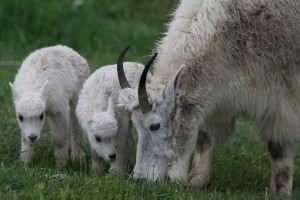
Mountain Goat
Description:
A relatively small bovid. Compact, short-legged body. Yellowish-white fur, long and shaggy in winter, shorter in summer; “beard,” about 5 ” long, retained year round. Eyes, nose, hooves, and horns black. Both sexes have backward curving, dagger-like horns, up to 12″ in the male, 9″ in female. Juvenile similar to adult, but with brown hars anlong back. Female approximately 15 percent smaller than male. Male (billy), Female (nanny), Young (kid) Ht. 35-47″; L 4-5’10” Avg wt: Male 154 – 180 lb. , Female 117 – 156 lb.
Breeding:
Mates mid-November through mid-December; gestation 6 months. 1-3 young born mid-May through mid-June. Newborn weighs about 6 ½ lb. Range: Natural range; extreme s Alaska, s Yukon, British Columbia, sw Alberta, parts of Wahington, n Idaho and nw Montana.
Interesting Facts
The Mountain Goat is not a true goat, but belongs to a group known as goat-antelopes, which includes the Chamois of Europe and Asia Minor. Its hooves are well adapted for rock peaks with a sharp outer rim that grips a rubbery sole that provides traction on steep or smooth surfaces. Avalanches and rock slides are the greatest killers of Mountain Goats, accounting for many more deaths than predation.



